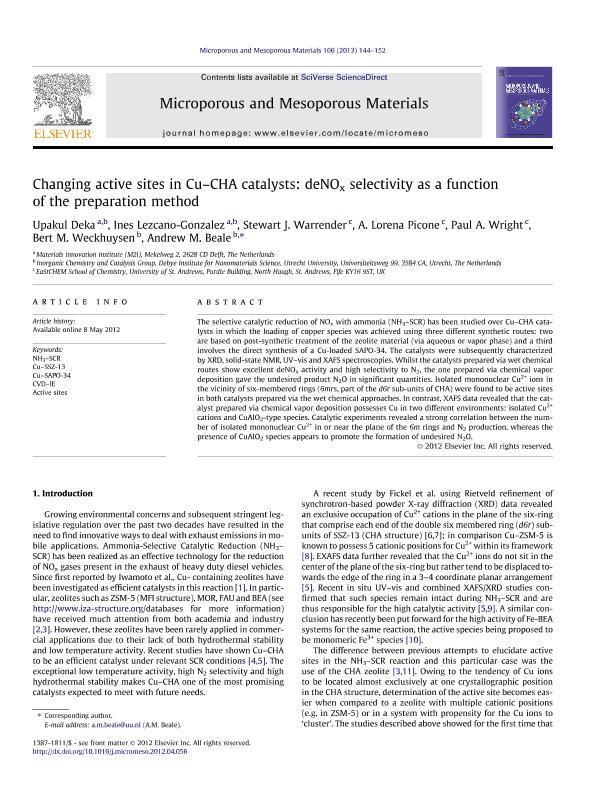Artículo
Changing active sites in Cu–CHA catalysts: deNOx selectivity as a function of the preparation method
Deka, Upakul; Lezcano Gonzalez, Ines; Warrender, Stewart J.; Picone, Andrea Lorena ; Wright, Paul A.; Weckhuysen, Bert M.; Beale, Andrew M.
; Wright, Paul A.; Weckhuysen, Bert M.; Beale, Andrew M.
 ; Wright, Paul A.; Weckhuysen, Bert M.; Beale, Andrew M.
; Wright, Paul A.; Weckhuysen, Bert M.; Beale, Andrew M.
Fecha de publicación:
01/2013
Editorial:
Elsevier Science
Revista:
Microporous and Mesoporous Materials
ISSN:
1387-1811
Idioma:
Inglés
Tipo de recurso:
Artículo publicado
Clasificación temática:
Resumen
The selective catalytic reduction of NO x with ammonia (NH 3-SCR) has been studied over Cu-CHA catalysts in which the loading of copper species was achieved using three different synthetic routes: two are based on post-synthetic treatment of the zeolite material (via aqueous or vapor phase) and a third involves the direct synthesis of a Cu-loaded SAPO-34. The catalysts were subsequently characterized by XRD, solid-state NMR, UV-vis and XAFS spectroscopies. Whilst the catalysts prepared via wet chemical routes show excellent deNO x activity and high selectivity to N 2, the one prepared via chemical vapor deposition gave the undesired product N 2O in significant quantities. Isolated mononuclear Cu 2+ ions in the vicinity of six-membered rings (6mrs, part of the d6r sub-units of CHA) were found to be active sites in both catalysts prepared via the wet chemical approaches. In contrast, XAFS data revealed that the catalyst prepared via chemical vapor deposition possesses Cu in two different environments: isolated Cu 2+ cations and CuAlO 2-type species. Catalytic experiments revealed a strong correlation between the number of isolated mononuclear Cu 2+ in or near the plane of the 6m rings and N 2 production, whereas the presence of CuAlO 2 species appears to promote the formation of undesired N 2O.
Palabras clave:
Active Sites
,
Cu-Sapo-34
,
Cu-Ssz-13
,
Cvd-Ie
,
Nh 3-Scr
Archivos asociados
Licencia
Identificadores
Colecciones
Articulos(CEQUINOR)
Articulos de CENTRO DE QUIMICA INORGANICA "DR. PEDRO J. AYMONINO"
Articulos de CENTRO DE QUIMICA INORGANICA "DR. PEDRO J. AYMONINO"
Citación
Deka, Upakul; Lezcano Gonzalez, Ines; Warrender, Stewart J.; Picone, Andrea Lorena; Wright, Paul A.; et al.; Changing active sites in Cu–CHA catalysts: deNOx selectivity as a function of the preparation method; Elsevier Science; Microporous and Mesoporous Materials; 166; 1-2013; 144-152
Compartir
Altmétricas



